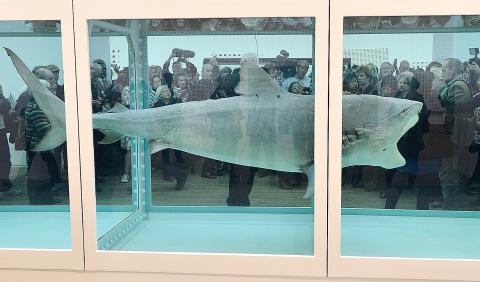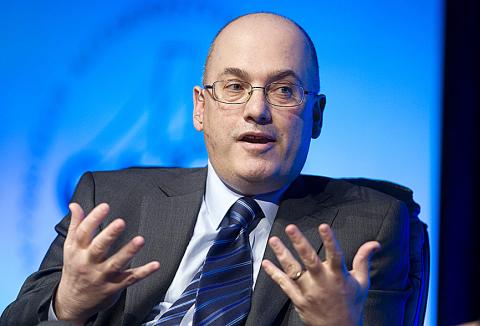The art world is watching to see the fate of billionaire hedge-fund owner Steven A. Cohen.
Cohen’s US$14 billion SAC Capital Advisors LP is facing an insider-trading case. The US Securities and Exchange Commission has told the hedge fund it is considering suing SAC for alleged insider trading. Federal prosecutors have charged Mathew Martoma, a former SAC Capital portfolio manager, and the SEC sued him civilly the same day.
Cohen, 56, is worth US$9.5 billion, according to the Bloomberg Billionaires Index. He is also one of the world’s biggest art collectors, with works by Van Gogh, Manet, de Kooning, Picasso, Cezanne, Warhol, Johns and Richter.

Photo: REUTERS
His purchases have helped boost prices of artists such as Damien Hirst, whose shark-in-formaldehyde he bought for US$8 million.
“He is known for his willingness to pay top prices for the best work,” Todd Levin, director of New York-based Levin Art Group, said in an interview. “In the worst case scenario, he might not be able to buy going forward and there will be some disappointed gallerists.”
Since he started his hedge fund in 1992, Cohen has achieved average annual returns of 30 percent, with just one money-losing year: 2008, when his main fund tumbled 19 percent.

Photo: REUTERS
Cohen started collecting art in about 2001. His taste has shifted from Impressionist to contemporary works.
An early purchase was Edouard Manet’s 1878 Self Portrait with a Palette which came from the collection of Las Vegas casino developer Steve Wynn. It probably cost Cohen between US$35 million and US$40 million, according to dealers with knowledge of the matter.
He sold it for US$33.2 million at Christie’s International, London, in June 2010, setting a record for the artist at auction.
Cohen often favors discreet, privately-brokered purchases, though he’s become a more visible presence on the gallery circuit.
In June, he made the rounds at the Art Basel fair wearing a baseball cap with the logo NERO above his trademark wire-rimmed glasses and zip-neck jersey. Dealers identified him as the buyer of Gerhard Richter’s 1986 abstract, A.B. Courbet which was on view in the booth of New York’s Pace Gallery, priced between $20 million and US$25 million.
A few selections suggest Cohen has a taste for the dark. He bought one of Francis Bacon’s screaming Pope canvases for about US$16 million, according to dealers.
The other creepy work, Hirst’s shark piece, The Physical Impossibility of Death in the Mind of Someone Living required a new shark when it became evident that the old one was definitely not only dead but obviously rotting.
He also owns the original version of Marc Quinn’s most famous creation: a head called Self and fashioned from the artist’s frozen blood.
In 2009, Cohen lent 20 artworks featuring women from his collection for an exhibition at Sotheby’s. Willem de Kooning’s Woman III (cost: US$137 million) joined pieces by Picasso, Cezanne and contemporary artists Marlene Dumas and Lisa Yuskavage. At the time, Bloomberg reported that the group was estimated to be worth about US$450 million.
Recently, Cohen sent another Richter abstract, Prag 1883 to a Christie’s auction on Nov. 14. Estimated at US$9 million to US$12 million, it failed to sell.
This was before the latest headlines started to break on insider-trading inquiries. Curiosity will grow if a question mark hangs over the future of his collection.
“Whether Steve Cohen owned the work neither adds nor detracts from its value,” Levin said of the Richter. “Provenance is a function of time and vision. And Cohen has been collecting seriously for about a decade. If he were to sell, he might take a loss depending on market timing.”
Jonathan Gasthalter, a spokesman for SAC, returned a telephone query from Bloomberg News on Nov. 30 by declining to comment on Cohen’s plans to buy or sell art.
“The market can absorb the loss of one collector,” said the London-based dealer Kenny Schachter. “It’s more a case of the vultures circling over what he’s bought. Cohen was always pruning and improving his collection. If he has to sell, his name isn’t a celebrity provenance that adds 25 percent to prices. The premium comes from knowing he always bought top quality.”

April 28 to May 4 During the Japanese colonial era, a city’s “first” high school typically served Japanese students, while Taiwanese attended the “second” high school. Only in Taichung was this reversed. That’s because when Taichung First High School opened its doors on May 1, 1915 to serve Taiwanese students who were previously barred from secondary education, it was the only high school in town. Former principal Hideo Azukisawa threatened to quit when the government in 1922 attempted to transfer the “first” designation to a new local high school for Japanese students, leading to this unusual situation. Prior to the Taichung First

The Ministry of Education last month proposed a nationwide ban on mobile devices in schools, aiming to curb concerns over student phone addiction. Under the revised regulation, which will take effect in August, teachers and schools will be required to collect mobile devices — including phones, laptops and wearables devices — for safekeeping during school hours, unless they are being used for educational purposes. For Chang Fong-ching (張鳳琴), the ban will have a positive impact. “It’s a good move,” says the professor in the department of

On April 17, Chinese Nationalist Party (KMT) Chairman Eric Chu (朱立倫) launched a bold campaign to revive and revitalize the KMT base by calling for an impromptu rally at the Taipei prosecutor’s offices to protest recent arrests of KMT recall campaigners over allegations of forgery and fraud involving signatures of dead voters. The protest had no time to apply for permits and was illegal, but that played into the sense of opposition grievance at alleged weaponization of the judiciary by the Democratic Progressive Party (DPP) to “annihilate” the opposition parties. Blamed for faltering recall campaigns and faced with a KMT chair

Article 2 of the Additional Articles of the Constitution of the Republic of China (中華民國憲法增修條文) stipulates that upon a vote of no confidence in the premier, the president can dissolve the legislature within 10 days. If the legislature is dissolved, a new legislative election must be held within 60 days, and the legislators’ terms will then be reckoned from that election. Two weeks ago Taipei Mayor Chiang Wan-an (蔣萬安) of the Chinese Nationalist Party (KMT) proposed that the legislature hold a vote of no confidence in the premier and dare the president to dissolve the legislature. The legislature is currently controlled